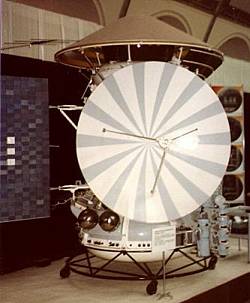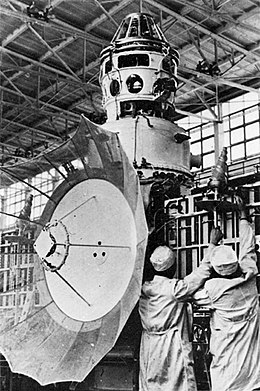Venera 2MV-1 No.2, also known as Sputnik 20 in the Western world, was a Soviet spacecraft, which was launched in 1962 as part of the Venera programme. Due to a problem with its upper stage it failed to leave low Earth orbit, and reentered the atmosphere a few days later. It was the second of two Venera 2MV-1 spacecraft, both of which failed to leave Earth orbit. The previous mission, Venera 2MV-1 No.1, was launched several days earlier.

Mars 1, also known as 1962 Beta Nu 1, Mars 2MV-4 and Sputnik 23, was an automatic interplanetary station launched in the direction of Mars on November 1, 1962, the first of the Soviet Mars probe program, with the intent of flying by the planet at a distance of about 11,000 km (6,800 mi). It was designed to image the surface and send back data on cosmic radiation, micrometeoroid impacts and Mars' magnetic field, radiation environment, atmospheric structure, and possible organic compounds.
Kosmos 21 was a Soviet spacecraft. This mission has been tentatively identified by NASA as a technology test of the Venera series space probes. It may have been an attempted Venus impact, presumably similar to the later Kosmos 27 mission, or it may have been intended from the beginning to remain in geocentric orbit. In any case, the spacecraft never left Earth orbit after insertion by the Molniya launcher. The orbit decayed on 14 November 1963, three days after launch.
Kosmos 27, also known as Zond 3MV-1 No.3 was a space mission intended as a Venus impact probe. The spacecraft was launched by a Molniya 8K78 carrier rocket from Baikonur. The Blok L stage and probe reached Earth orbit successfully, but the attitude control system failed to operate.
Zond was the name given to two distinct series of Soviet robotic spacecraft launched between 1964 and 1970. The first series, based on the 3MV planetary probe, was intended to gather information about nearby planets.

Zond 3 was a 1965 space probe which performed a flyby of the Moon's far side, taking a number of quality photographs for its time. It was a member of the Soviet Zond program while also being part of the Mars 3MV project. It was unrelated to Zond spacecraft designed for crewed circumlunar missions. It is believed that Zond 3 was initially designed as a companion spacecraft to Zond 2 to be launched to Mars during the 1964 launch window. The opportunity to launch was missed, and the spacecraft was launched on a Mars-crossing trajectory as a spacecraft test, even though Mars was no longer attainable.

Venera 3 was a Venera program space probe that was built and launched by the Soviet Union to explore the surface of Venus. It was launched on 16 November 1965 at 04:19 UTC from Baikonur, Kazakhstan, USSR. The probe comprised an entry probe, designed to enter the Venus atmosphere and parachute to the surface, and a carrier/flyby spacecraft, which carried the entry probe to Venus and also served as a communications relay for the entry probe.

Zond 1 was a spacecraft of the Soviet Zond program. It was the second Soviet research spacecraft to reach Venus, although communications had failed by that time. It carried a 90-centimetre (35 in) spherical landing capsule, containing experiments for chemical analysis of the atmosphere, gamma-ray measurements of surface rocks, a photometer, temperature and pressure gauges, and a motion/rocking sensor in case it landed in water.

Venera 2, also known as 3MV-4 No.4 was a Soviet spacecraft intended to explore Venus. A 3MV-4 spacecraft launched as part of the Venera programme, it failed to return data after flying past Venus.
Venera 2MV-2 No.1, also known as Sputnik 21 in the West, was a Soviet spacecraft, which was launched in 1962 as part of the Venera programme, and was intended to make a flyby of Venus. Due to a problem with the rocket which launched it, it failed to leave low Earth orbit, and reentered the atmosphere a few days later. It was the second Venera 2MV-2 spacecraft, both of which failed to leave Earth orbit.
Zond 3MV-1 No.2, also known as Venera 1964A in the West, was a Soviet spacecraft, which was launched in 1964 as part of the Zond program. Due to a problem with its carrier rocket third stage, it failed to reach low Earth orbit.
Kosmos 96, or 3MV-4 No.6, was a Soviet spacecraft intended to explore Venus. A 3MV-4 spacecraft launched as part of the Venera programme, Kosmos 96 was to have made a flyby of Venus, however, due to a launch failure, it did not depart low Earth orbit. Its re-entry into Earth's atmosphere is often speculated as the cause of the Kecksburg UFO incident.
Kosmos 167, or 4V-1 No.311, was a 1967 Soviet spacecraft intended to explore Venus. A spacecraft launched as part of the Venera programme, Kosmos 167 was intended to land on Venus but never departed low Earth orbit due to a launch failure.

The 4MV planetary probe is a designation for a common design used for Soviet unmanned probes to Mars and Venus.

The 2MV planetary probe is a designation for a common design used by early Soviet uncrewed probes to Mars and Venus.

The 1MV planetary probe is a designation for a common design used by early Soviet uncrewed probes to Mars and Venus. It was standard practice of the Soviet space program to use standardized components as much as possible.
The following outline is provided as an overview of and topical guide to Venus:

The Mars-69/M-69 or 2M was the designation given to 2 Soviet Mars probes that were to be sent in 1969. Based on the Luna E-8 landers used for Luna 15-24, they were the first attempted Mars and Interplanetary Orbiters. The probes, however, were both destroyed in separate launches in early 1969.

The KDU-414, is a pressure-fed liquid rocket Propulsion Unit developed and produced by the Isayev Design Bureau. From 1960 onward, it powered several unmanned Soviet Spacecraft, including the first series of Molniya satellites, several Kosmos satellites as well as the space probes Mars 1, Venera 1, Zond 2 and Zond 3, featured as a part of standardized spacecraft buses known as KAUR-2, 2MV and 3MV.









